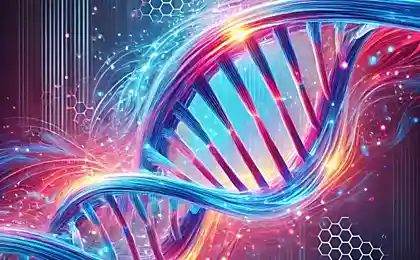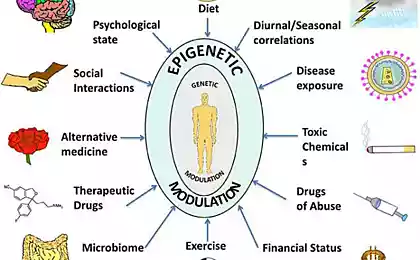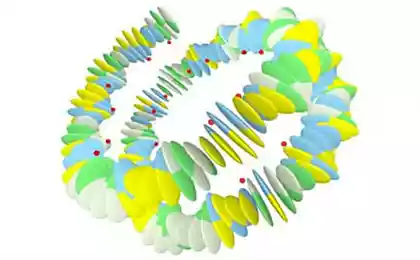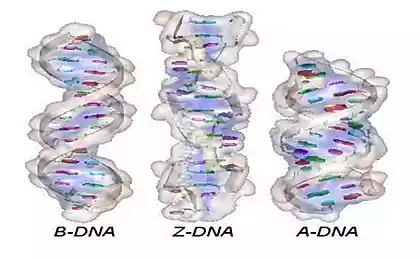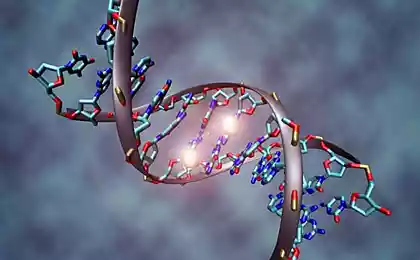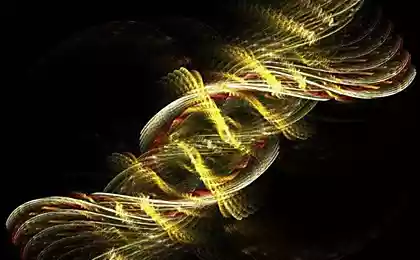573
The DNA helix is the bridge from potential to manifest
What is life? This question became the driving force behind the development of genetics (from the Greek genetikos "belonging to birth, origin") is the science of the origin of life, which for more than 50 years, is a molecule of DNA.
A discovery that turned the world
"We have just discovered the secret of life!"— on February 28 1953 Francis Crick and James Watson announced their discovery of DNA structure. What is new is bringing it to life Sciences? Before that it was known that DNA is a big molecule, in which by means of "four-letter alphabet" contains information on the structure and properties of living beings. But it remained unclear how this information is passed on from generation to generation and materialized in these same structures and properties as well as what is the spatial structure of DNA.
Ninety eight million seven hundred twenty one thousand seven hundred forty seven
Unraveling the structure of DNA helped scientists to understand the mechanisms of copying and materialization. DNA consists of two chains that are complementary (complementary) to each other. The copying of DNA is due to completing on each of the original DNA chain, as the matrix, the additional copies. So one of the DNA double helix we have two absolutely identical double helix that is necessary to preserve genetic information when dividing the mother cell into two daughter. The matrix principle is the basis of the gradual materialization of genetic information: one of the DNA strands is formed complementary to her chain the other information of the molecule — RNA, which, in turn, serves as a matrix for protein synthesis, the number and quality of which depend on the structure and properties of a particular organism.
How this discovery is significant for understanding the mysteries of life? On the one hand, knowledge of the structure of DNA is clearly not sufficient to answer the question "what is life?". But on the other — this discovery was made "science" a very ancient and very important question of the relationship between potential and manifested, for example, information about the structures and properties of the body by structures and properties. And not only put this question, but gave the key to the answer. The key — matrix principle, the principle of complementarity.
The path from gene to trait
That means the classic phrase from the textbook: "DNA — the carrier of genetic information"? As genetic information is linked with the structure of DNA? How the information is embodied in the specific properties of the organism? If the point of reference of genetic information to adopt the DNA structure and follow the structural model, the path from gene to trait would look like: in a DNA sequence is encrypted all properties of an organism; the linear structure of a specific gene uniquely determines the linear structure of the corresponding protein, which, in turn, clearly defines the role of this protein in the formation of a symptom.
In other words, "DNA produces RNA; the RNA produces protein, and the protein gives birth to us" (F. Crick). If this is true, then in order to change a particular characteristic (for example, to cure a disease with genetic roots), is sufficient to establish corresponding phase sequence of the DNA and fix it.
But is it simple? If you have enough knowledge (even though they are unquestionably true and necessary!) on the structural correspondences on the path from the gene to the trait in order to understand and play this way?
The latest achievements of genetics have shown that insufficient. In 2003, in the framework of the project "human Genome" have been fully defined linear structure of human DNA (and many other simple and complex organisms). As one of the scientists, "read all the letters, who wrote a thick book, even now, would understand the words and their meaning."
It turned out that the actual genes (DNA segments that encode proteins) in humans about 30 000, and it is only 1-3% of the total DNA! The same genes in the plant Arabidopsis taliana and puffer fish. Moreover, 99% of human genes coincide with genes of the mouse, that is, people have only 300 genes that have no mouse. (It's hard to imagine that we have and mice are still the same and 99% signs!)
Further — more. It turned out that a definite relationship between the gene and the protein only exists in bacteria. But in humans, the formation of many proteins on the basis of one gene (the most famous today, the number of different proteins encoded by one gene, and 40 000!) and the occurrence of many functions in one protein. It turns out that the path from potential to manifest, from genetic information to the characteristic is not linear; each symptom is the result of complex interactions of many genes and their products-proteins; that the very notion of "gene" because of its ambiguity can hardly serve as the starting point of this path.
Forty seven million five hundred one thousand six hundred sixty five
The interaction of structures
The human body consists of 10 to 14-degree cells. They all have exactly the same DNA, but differ substantially in shape, size and their objectives. The resolution of this paradox in selective gene transcription. In each cell are active only the genes that it is necessary at this time.
The selectivity provided by special genes and regulators that allow or deny reading information from a particular section of DNA. The activity of a gene depends on its environment in the space of the cell nucleus. The change of environment caused by the movement of the gene or one of its neighbors, is able to change its activity ("off" or "switch on" the gene).
For example, in the human genome there are lots of potentially harmful viral genes and proto-oncogenes (can cause cancerous degeneration of the cells). They can for a long time (and life) to behave peacefully and work for the benefit of the cell until the move themselves or someone from the environment does not identify in these genes the aggressive potentials. Fortunately, there may be other movements that will calm the "rebel" or will turn on protective mechanisms.
So, the carrier of genetic information has moved from the level of genes (specific DNA sequence) on the epigenetic (from the Latin, "above", "above") the level of interaction of genes with each other and with other structures of the cell nucleus (99% nagelneu DNA and proteins). Suppose science will decipher the mechanism of this interaction. Whether this will lead to the secret of life? Life is only structure? And if not, whether in search of clues to the mysteries of life limited to the interaction of structures?
Who guards the guards?
As a single cell in a result, 46 divisions of the result is not a shapeless mass of 1014 cells and a highly distinctive body of each of us? Consistently doubling, the cells not only become different, but also form different parts of the body at the right time and in the right place. What controls the organization of cells in time and space?
Whole which is qualitatively more than the simple sum of its parts-the cells. And this does not contradict the fact that the body is formed from a single cell — the question is that this cell embodies the "will of the whole." The search for such a regulating factor resulted in the beginning of XX century the concept of morphogenetic fields. Its founder was the Russian scientist A. G. Gurvich. When Gurvich worked on field theory, the DNA molecule was considered to be an integral part of the chromosomes, and she didn't give it much thought.
In 1944, the scientist published his work "the Theory of biological field." This year has been momentous for the whole of genetics, defining the path of its development for decades to come. The focus of the scientists were the DNA molecule because it has been proven that it played a leading role in the transmission of hereditary information. Not far off was 1953... as a result, all his attention focused on the science of the structure of DNA, which actually began to identify with a transfer of its information, and the theory of biological field was not held in high esteem. But research in this area continued, and all these years, two ways of knowing the mysteries of life were parallel...
The transition into the new Millennium changed the balance of forces in the life Sciences. More and more scientists coming to the conclusion that the structural key in the realization of the living a necessary but not sufficient; what different approaches do not exclude each other and form United way of scientific research; it is essentially a structural approach and the theory of fields complementary.
Remember: it is the assumption of complementarity of DNA chains was the key to deciphering its structure, and the opening of 1953 was made possible thanks to the complementarity of efforts of representatives of different fields of science — physicists, chemists, biologists. Maybe combined the science of the new Millennium, not only will finally reconcile different scientific approaches (e.g., structural and field), but will turn to the fruit of "unscientific" ways of knowing the secrets of life, the millennial wisdom of humanity — the "unscientific" because this path is rooted in the days when science was not in sight.
Turning to sources of ancient wisdom can give to science the keys to the door, behind which is hidden the mystery. But for this to happen, so many different ways of knowing should be "intersect". One of these "intersections" could be the concept of morphogenetic fields (biological, morphogenetic, information), grown on the soil of modern science and rising to the phenomena discussed in ancient sources.
The latter say that man consists of several bodies, or principles, which are not separate, independent parts, and vzaimopronikayut interpenetrate and complement each other; the visible dense physical body is the conduit, a carrier of more subtle bodies, which with the help of manifest in the physical world and interact with it; that "Assembly" — the formation of the physical body of the elements of physical matter — controls most "dense" of these bodies, the astral body is the prototype (pattern, matrix).
Modern science knows that each newly formed cell involved in the formation of the body according to individual "user" (active, or enabled, genes) and that the parent and descendants of that cell can be quite different "instructions". But what and how to coordinate switching of individual "programmes" the development of billions of cells, is not clear.
The theory of biological field suggests that coordination is a function of the whole, which is thus a field, matrix, or model; that each newly formed cell with your own genetic apparatus is connected to a single "plan" for the development of the body, get individual instructions and implements them in the framework of the program behavior.
It turns out that the genetic machinery of cells consists of at least three functional units: the perceiver as an "antenna", "remote control" the activity of genes and "Executive" part of the genes responsible for the formation of specific proteins. Remember that genes account for only 1-2% of all cellular DNA. In the remaining 98-99% of the DNA already discovered the structure related to the second "control unit". What plays the role of "antenna"? Where there is "meeting of two worlds" — of the information field and genetic structures embodying this information in a particular physical body?
Seventy six million nine hundred seventy one thousand two hundred twenty eight
The bridge from potential to manifest
Why not assume the role of an antenna that can capture, transform and transmit signals to the wave nature, too, plays DNA? To this has and the spiral structure of the "molecules of life" (a technical antennas have a spiral shape) and properties such as the ability to conduct an electric current, the possibility of resonant excitation of longitudinal oscillations under the influence of radio waves, as well as the ability to generate laser light after prior "pump".
If DNA can operate on receiving the information, providing the vital activity of the cells, it does not have to store this information in its structure. As, for example, the human brain to successfully control the body's vital systems, do not have to be a "repository" of the mind, but rather to play the role of mediator between consciousness and the body: he perceives information from the plan of consciousness and "translates" it into the language of the management body.
And it's clear why in the case of damage of the structure of DNA (or brain structures) suffers a physical body. Because we all know that if there is a fault in the TV, at least one part of the image on the screen is highly distorted, and if the TV antenna to deprive or disable it from the network, on the screen nothing will appear.
A DNA link between the "model" of the physical body and its specific embodiment. The brain is mediator between mind and body. The mind connects the life and form of its manifestation and allows life confined in a form to know itself. With the help of this wonderful tool has the opportunity to explore the world and find in it the key to the knowledge of his inner world. Thus was born the United way leading to the knowledge of the mystery of life. For man is the greatest of mysteries — the mystery of the relationship between earth and heaven.published
P. S. And remember, only by changing their consumption — together we change the world! ©
Join us in Facebook , Vkontakte, Odnoklassniki
Source: www.newacropolis.ru/magazines/4_2005/DNK/
A discovery that turned the world
"We have just discovered the secret of life!"— on February 28 1953 Francis Crick and James Watson announced their discovery of DNA structure. What is new is bringing it to life Sciences? Before that it was known that DNA is a big molecule, in which by means of "four-letter alphabet" contains information on the structure and properties of living beings. But it remained unclear how this information is passed on from generation to generation and materialized in these same structures and properties as well as what is the spatial structure of DNA.
Ninety eight million seven hundred twenty one thousand seven hundred forty seven
Unraveling the structure of DNA helped scientists to understand the mechanisms of copying and materialization. DNA consists of two chains that are complementary (complementary) to each other. The copying of DNA is due to completing on each of the original DNA chain, as the matrix, the additional copies. So one of the DNA double helix we have two absolutely identical double helix that is necessary to preserve genetic information when dividing the mother cell into two daughter. The matrix principle is the basis of the gradual materialization of genetic information: one of the DNA strands is formed complementary to her chain the other information of the molecule — RNA, which, in turn, serves as a matrix for protein synthesis, the number and quality of which depend on the structure and properties of a particular organism.
How this discovery is significant for understanding the mysteries of life? On the one hand, knowledge of the structure of DNA is clearly not sufficient to answer the question "what is life?". But on the other — this discovery was made "science" a very ancient and very important question of the relationship between potential and manifested, for example, information about the structures and properties of the body by structures and properties. And not only put this question, but gave the key to the answer. The key — matrix principle, the principle of complementarity.
The path from gene to trait
That means the classic phrase from the textbook: "DNA — the carrier of genetic information"? As genetic information is linked with the structure of DNA? How the information is embodied in the specific properties of the organism? If the point of reference of genetic information to adopt the DNA structure and follow the structural model, the path from gene to trait would look like: in a DNA sequence is encrypted all properties of an organism; the linear structure of a specific gene uniquely determines the linear structure of the corresponding protein, which, in turn, clearly defines the role of this protein in the formation of a symptom.
In other words, "DNA produces RNA; the RNA produces protein, and the protein gives birth to us" (F. Crick). If this is true, then in order to change a particular characteristic (for example, to cure a disease with genetic roots), is sufficient to establish corresponding phase sequence of the DNA and fix it.
But is it simple? If you have enough knowledge (even though they are unquestionably true and necessary!) on the structural correspondences on the path from the gene to the trait in order to understand and play this way?
The latest achievements of genetics have shown that insufficient. In 2003, in the framework of the project "human Genome" have been fully defined linear structure of human DNA (and many other simple and complex organisms). As one of the scientists, "read all the letters, who wrote a thick book, even now, would understand the words and their meaning."
It turned out that the actual genes (DNA segments that encode proteins) in humans about 30 000, and it is only 1-3% of the total DNA! The same genes in the plant Arabidopsis taliana and puffer fish. Moreover, 99% of human genes coincide with genes of the mouse, that is, people have only 300 genes that have no mouse. (It's hard to imagine that we have and mice are still the same and 99% signs!)
Further — more. It turned out that a definite relationship between the gene and the protein only exists in bacteria. But in humans, the formation of many proteins on the basis of one gene (the most famous today, the number of different proteins encoded by one gene, and 40 000!) and the occurrence of many functions in one protein. It turns out that the path from potential to manifest, from genetic information to the characteristic is not linear; each symptom is the result of complex interactions of many genes and their products-proteins; that the very notion of "gene" because of its ambiguity can hardly serve as the starting point of this path.
Forty seven million five hundred one thousand six hundred sixty five
The interaction of structures
The human body consists of 10 to 14-degree cells. They all have exactly the same DNA, but differ substantially in shape, size and their objectives. The resolution of this paradox in selective gene transcription. In each cell are active only the genes that it is necessary at this time.
The selectivity provided by special genes and regulators that allow or deny reading information from a particular section of DNA. The activity of a gene depends on its environment in the space of the cell nucleus. The change of environment caused by the movement of the gene or one of its neighbors, is able to change its activity ("off" or "switch on" the gene).
For example, in the human genome there are lots of potentially harmful viral genes and proto-oncogenes (can cause cancerous degeneration of the cells). They can for a long time (and life) to behave peacefully and work for the benefit of the cell until the move themselves or someone from the environment does not identify in these genes the aggressive potentials. Fortunately, there may be other movements that will calm the "rebel" or will turn on protective mechanisms.
So, the carrier of genetic information has moved from the level of genes (specific DNA sequence) on the epigenetic (from the Latin, "above", "above") the level of interaction of genes with each other and with other structures of the cell nucleus (99% nagelneu DNA and proteins). Suppose science will decipher the mechanism of this interaction. Whether this will lead to the secret of life? Life is only structure? And if not, whether in search of clues to the mysteries of life limited to the interaction of structures?
Who guards the guards?
As a single cell in a result, 46 divisions of the result is not a shapeless mass of 1014 cells and a highly distinctive body of each of us? Consistently doubling, the cells not only become different, but also form different parts of the body at the right time and in the right place. What controls the organization of cells in time and space?
Whole which is qualitatively more than the simple sum of its parts-the cells. And this does not contradict the fact that the body is formed from a single cell — the question is that this cell embodies the "will of the whole." The search for such a regulating factor resulted in the beginning of XX century the concept of morphogenetic fields. Its founder was the Russian scientist A. G. Gurvich. When Gurvich worked on field theory, the DNA molecule was considered to be an integral part of the chromosomes, and she didn't give it much thought.
In 1944, the scientist published his work "the Theory of biological field." This year has been momentous for the whole of genetics, defining the path of its development for decades to come. The focus of the scientists were the DNA molecule because it has been proven that it played a leading role in the transmission of hereditary information. Not far off was 1953... as a result, all his attention focused on the science of the structure of DNA, which actually began to identify with a transfer of its information, and the theory of biological field was not held in high esteem. But research in this area continued, and all these years, two ways of knowing the mysteries of life were parallel...
The transition into the new Millennium changed the balance of forces in the life Sciences. More and more scientists coming to the conclusion that the structural key in the realization of the living a necessary but not sufficient; what different approaches do not exclude each other and form United way of scientific research; it is essentially a structural approach and the theory of fields complementary.
Remember: it is the assumption of complementarity of DNA chains was the key to deciphering its structure, and the opening of 1953 was made possible thanks to the complementarity of efforts of representatives of different fields of science — physicists, chemists, biologists. Maybe combined the science of the new Millennium, not only will finally reconcile different scientific approaches (e.g., structural and field), but will turn to the fruit of "unscientific" ways of knowing the secrets of life, the millennial wisdom of humanity — the "unscientific" because this path is rooted in the days when science was not in sight.
Turning to sources of ancient wisdom can give to science the keys to the door, behind which is hidden the mystery. But for this to happen, so many different ways of knowing should be "intersect". One of these "intersections" could be the concept of morphogenetic fields (biological, morphogenetic, information), grown on the soil of modern science and rising to the phenomena discussed in ancient sources.
The latter say that man consists of several bodies, or principles, which are not separate, independent parts, and vzaimopronikayut interpenetrate and complement each other; the visible dense physical body is the conduit, a carrier of more subtle bodies, which with the help of manifest in the physical world and interact with it; that "Assembly" — the formation of the physical body of the elements of physical matter — controls most "dense" of these bodies, the astral body is the prototype (pattern, matrix).
Modern science knows that each newly formed cell involved in the formation of the body according to individual "user" (active, or enabled, genes) and that the parent and descendants of that cell can be quite different "instructions". But what and how to coordinate switching of individual "programmes" the development of billions of cells, is not clear.
The theory of biological field suggests that coordination is a function of the whole, which is thus a field, matrix, or model; that each newly formed cell with your own genetic apparatus is connected to a single "plan" for the development of the body, get individual instructions and implements them in the framework of the program behavior.
It turns out that the genetic machinery of cells consists of at least three functional units: the perceiver as an "antenna", "remote control" the activity of genes and "Executive" part of the genes responsible for the formation of specific proteins. Remember that genes account for only 1-2% of all cellular DNA. In the remaining 98-99% of the DNA already discovered the structure related to the second "control unit". What plays the role of "antenna"? Where there is "meeting of two worlds" — of the information field and genetic structures embodying this information in a particular physical body?
Seventy six million nine hundred seventy one thousand two hundred twenty eight
The bridge from potential to manifest
Why not assume the role of an antenna that can capture, transform and transmit signals to the wave nature, too, plays DNA? To this has and the spiral structure of the "molecules of life" (a technical antennas have a spiral shape) and properties such as the ability to conduct an electric current, the possibility of resonant excitation of longitudinal oscillations under the influence of radio waves, as well as the ability to generate laser light after prior "pump".
If DNA can operate on receiving the information, providing the vital activity of the cells, it does not have to store this information in its structure. As, for example, the human brain to successfully control the body's vital systems, do not have to be a "repository" of the mind, but rather to play the role of mediator between consciousness and the body: he perceives information from the plan of consciousness and "translates" it into the language of the management body.
And it's clear why in the case of damage of the structure of DNA (or brain structures) suffers a physical body. Because we all know that if there is a fault in the TV, at least one part of the image on the screen is highly distorted, and if the TV antenna to deprive or disable it from the network, on the screen nothing will appear.
A DNA link between the "model" of the physical body and its specific embodiment. The brain is mediator between mind and body. The mind connects the life and form of its manifestation and allows life confined in a form to know itself. With the help of this wonderful tool has the opportunity to explore the world and find in it the key to the knowledge of his inner world. Thus was born the United way leading to the knowledge of the mystery of life. For man is the greatest of mysteries — the mystery of the relationship between earth and heaven.published
P. S. And remember, only by changing their consumption — together we change the world! ©
Join us in Facebook , Vkontakte, Odnoklassniki
Source: www.newacropolis.ru/magazines/4_2005/DNK/
